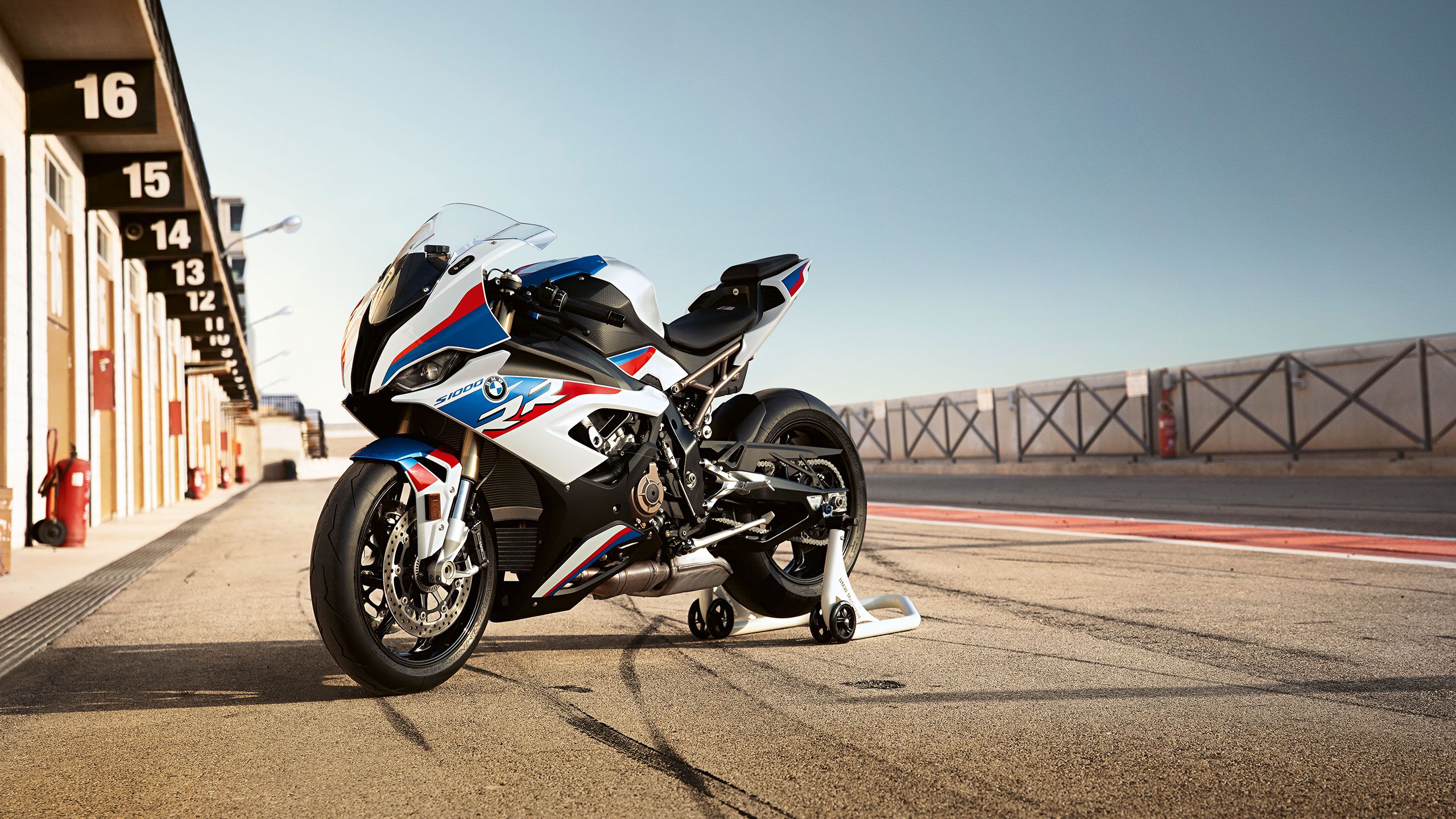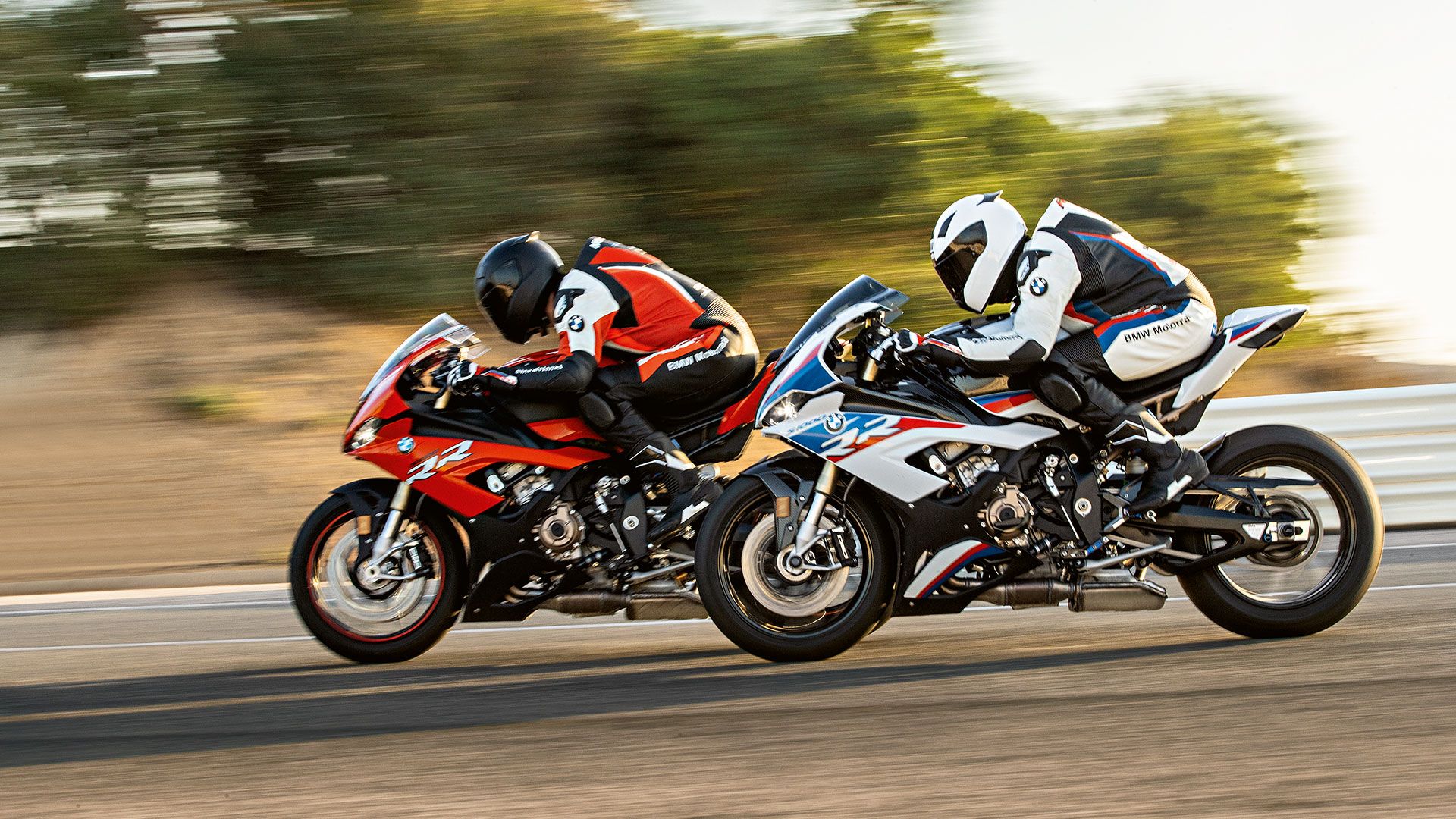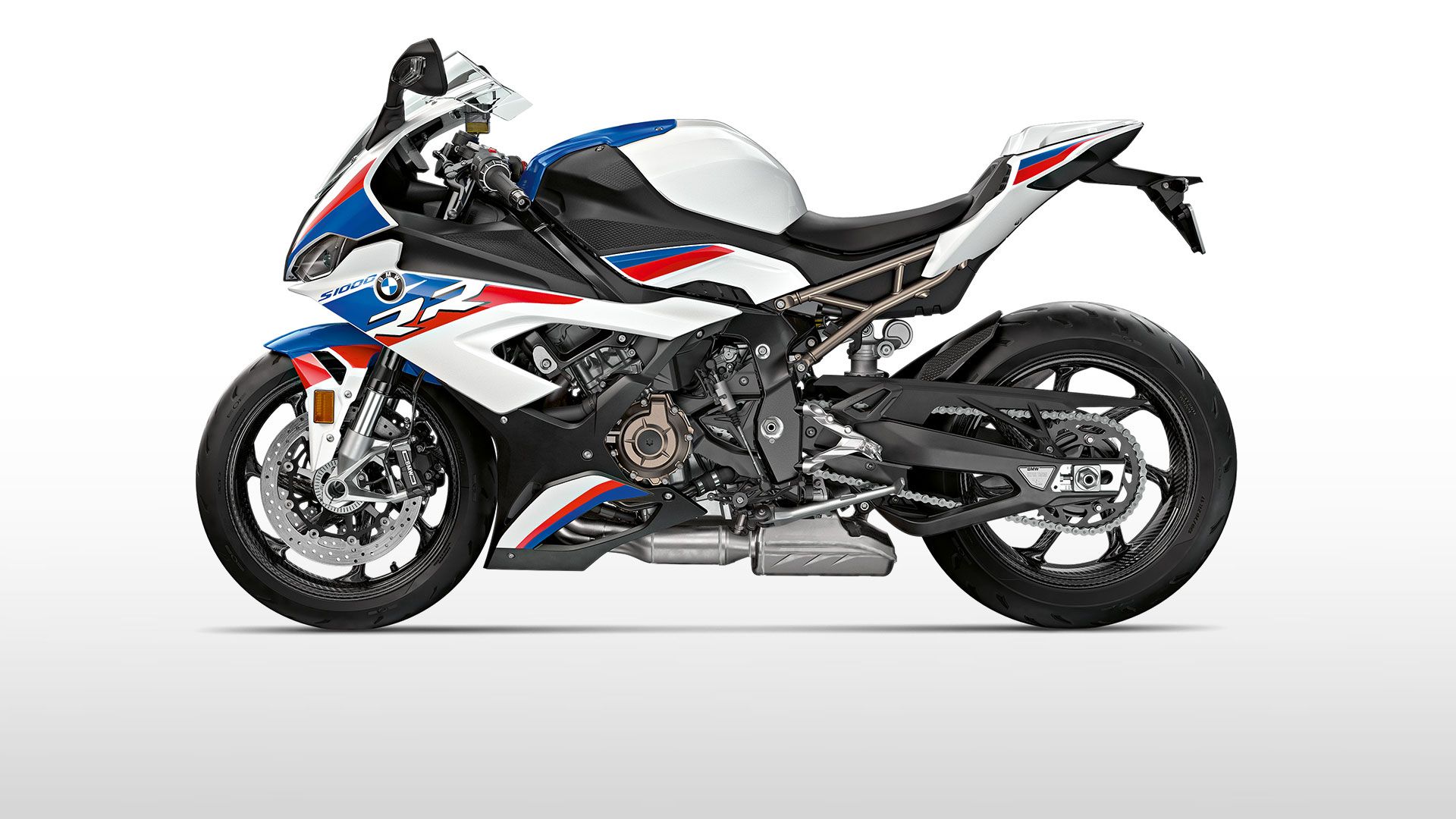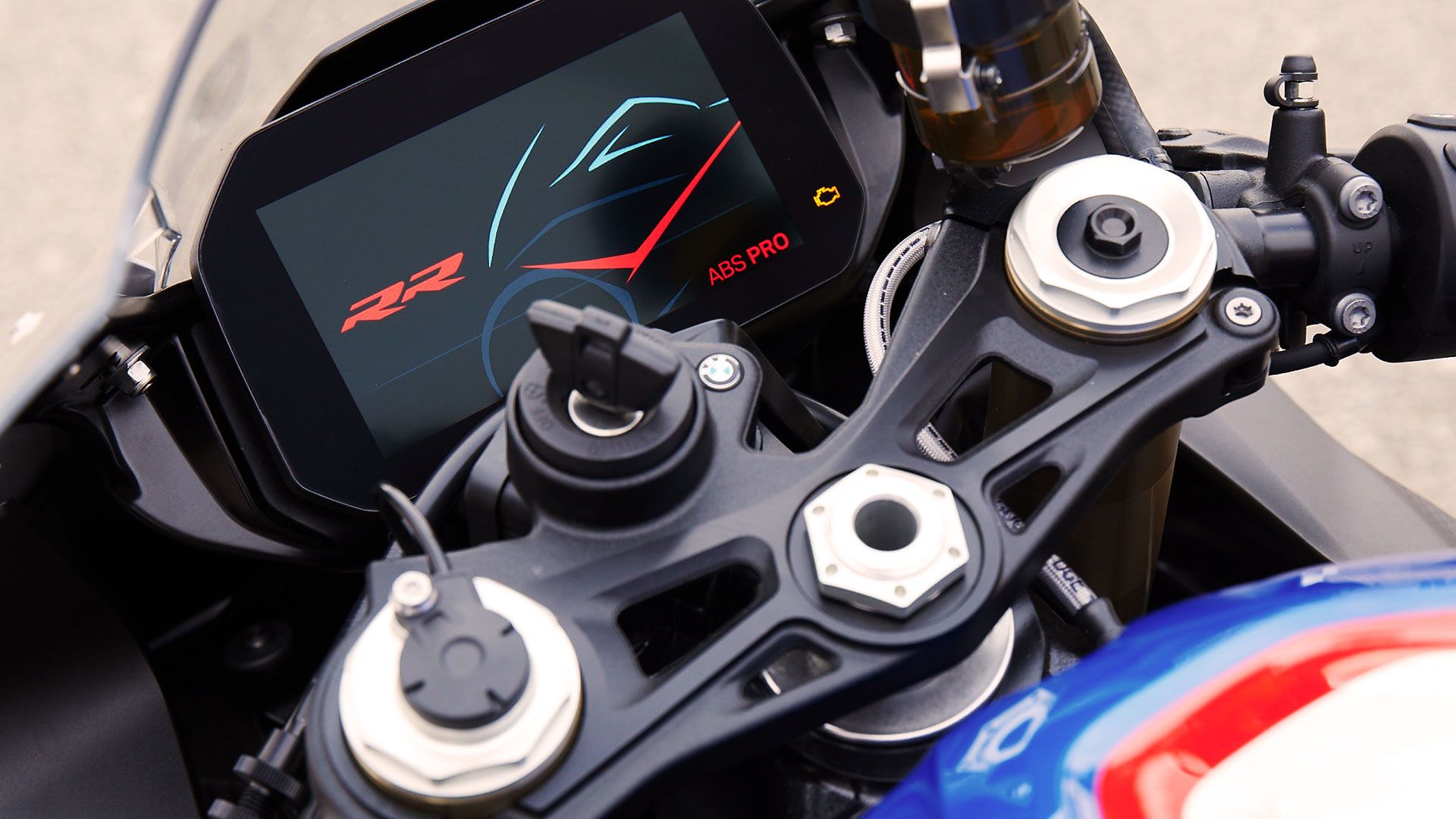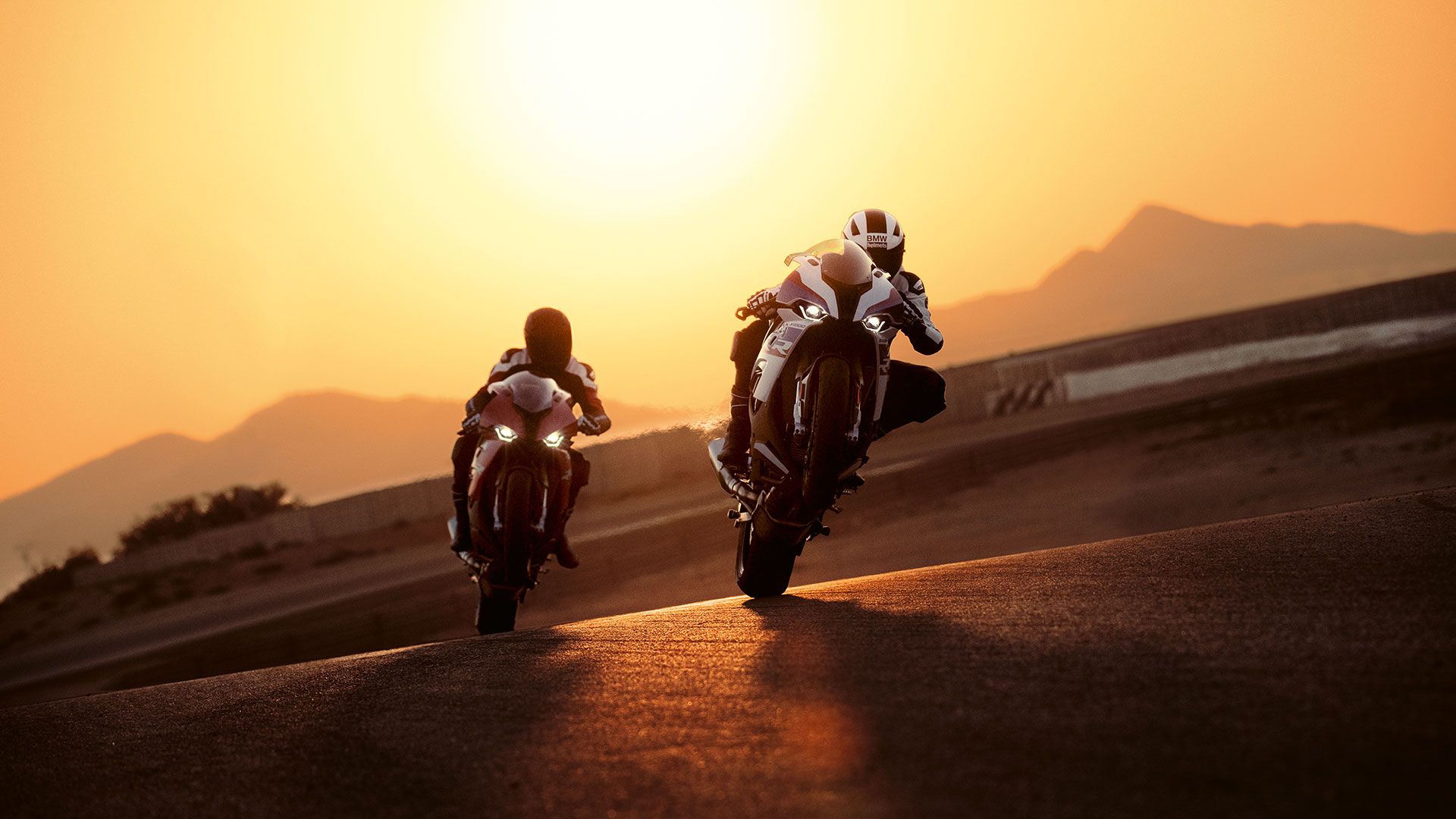The Bayerische Motoren Werke led off its 2020 lineup with a new version of its race-tastic S 1000 RR. As usual, for BMW, items that were optional equipment previously are now part of the standard equipment package including all-around LED lighting, lean-sensitive ABS, and an adjustable clutch lever. The 999 cc powerplant shed some weight and took on the ShiftCam technology to deepen the torque well a bit and pick up a few ponies in the process.
2022 BMW S 1000 RR Performance and Capability
Power comes from a spruced-up inline-four plant. The 2022 BMW S 1000 RR produces a whopping 205 horsepower at 13,000 rpm – five more ponies than last year – and 83 pound-feet of grunt at 11,000 rpm.
An 80 mm bore and 49.7 mm stroke keeps displacement just below a liter at 999 cc and gives the mill a 13.3-to-1 compression ratio. Yeah, it's sizzlin' hot, but at the end of the day, that power has to come from somewhere, right?
Capping the jugs, a 16-valve head rocks a quartet of hollow-drilled titanium valves per bore with DOHC actuation. The system uses Beemer's ShiftCam feature that rotates the intake cam relative to its drive to broaden the torque band.
A ride-by-wire throttle-control system sends the signal from your wrist to the engine control with a number of modifiers that include four Ride Modes as part of the standard equipment. If you're really into track work, the Ride Modes Pro delivers a trio of profiles that combine throttle control, wheelie- and traction control, and ABS for easy one-click setup changes.
Power flows through an oil-bathed slipper clutch for a lighter clutch-lever pull. It also prevents excessive backtorque from building up in the drivetrain which would otherwise endanger the rear contact patch.
This combination of gadgetry and engineering will drive the new version of the BMW S1000RR to speeds of 125 mph or better according to the factory Word on the street says there's a BMW S 1000 RR top speed of 188 mph.
|
Engine & Drivetrain |
|
|
Engine: |
Liquid cooled, 4-stroke in-line 4-cylinder engine, four titanium valves per cylinder, double overhead camshafts, wet sump lubrication, BMW ShiftCam |
|
Bore x Stroke: |
80 mm x 49.7 mm |
|
Displacement: |
999 cc |
|
Rated Output: |
205 hp (151 kW) @ 13,000 rpm |
|
Max. Torque: |
83 lb-ft (113 Nm) @ 11,000 rpm |
|
Compression ratio: |
13.3:1 |
|
Mixture Control / Engine Management: |
Electronic fuel injection with ride-by-wire throttle system, variable intake, and knock sensor |
|
Emission Control: |
Closed-loop 3-way catalytic converter, emission standard EU-4 |
|
Clutch: |
Multi-disc clutch in oil bath, anti-hopping clutch, mechanically operated, integrally-reinforced |
|
Gearbox: |
Constant-mesh 6-speed gearbox with straight cut gears |
|
Drive: |
Chain 525 17/45 |
Design
Beemer spent some time in the wind tunnel to give the third-generation S 1000 RR a new fairing/cowling design with optimized aerodynamics and low-drag penetration to help you get the most out of the upgraded mill.
The new body cladding and other weight-saving measures deliver a 434-pound wet weight. That's down from 459 pounds last year.
If you opt for the race-tastic “M” package, it rotates the stock wheels out in favor of carbon-fiber rims. Switching the wheels drops another 7.7-pounds from the overall curb weight.
A minimal front fender rocks a pair of vents. This further lightens the unsprung load to keep the forks supple and responsive, and it keeps the front contact patch firmly planted.
Dual headlights ride in squinted recesses in the front fairing. New for last year, the headlights and front turn signals all use LED technology.
To make it easy to set up for track days, the factory integrated the blinkers and the mirrors. This allows you to shed both at once for quick and easy race prep.
Clip-on bars encourage an aggressive riding posture, and underneath the clear bubble screen, you'll find a 6.5-inch color TFT screen. The display handles all the instrumentation and acts as an interface for ride-quality electronics.
The fairing forms a full cowling scoop with cheeks that extend back past the 4.4-gallon fuel tank to the pilot's saddle. A solo seat is the default configuration, but if you want to share the fun with a friend, you can opt for the pillion pad and passenger footpegs for no extra charge.
The standard seat rides 32.4-inches off the ground. If you spring for the race-tastic M package, you'll choose from a trio of seats that range from 32-inches to 33.4-inches high so you can dial it in right where you want it.
An upswept subframe gives the “RR” a nose-down/tail-up attitude. The rear end is easy to clean up for racing with a composite brake/turn/tail lights combined on a short mudguard along with the license plate for easy removal as a unit. Much of the spray control falls to the swingarm-mount hugger anyway.
|
BMW S 1000 RR Specs |
|
|
Length: |
81.6 in. (2,073 mm) |
|
Width (incl. mirrors): |
33.4 in. (848 mm) |
|
Height (excl. mirrors): |
45.3 in. (1,151 mm) |
|
Wheelbase: |
56.7 in. (1,441 mm) |
|
Seat Height, Unladen: |
Standard Seat: 32.4 in. |
|
Inner Leg Curve, Unladen: |
Standard Seat: 71.9 in. |
|
Curb Weight: |
Standard: 434 lbs (197 kg), M Package: 427 lbs (193.5 kg) |
|
Permitted total weight: |
895 lbs (407 kg) |
|
Payload (With Standard Equipment): |
463 lbs (210 kg) |
|
Fuel Consumption: |
37 mpg (WMTC) |
|
Fuel Capacity: |
4.4 gal (16.5 l), approx. 1 gal (4 l) reserve |
|
Top speed: |
188 mph (est) |
Chassis
A composite-aluminum bridge-type frame on the S 1000 RR provides the main structure. In a weight-saving measure, the engine is a stressed unit to eliminate some of the frame tubing.
Out back, a WSBK-inspired, yoke-style aluminum swingarm completes the standing rigging. It has a full-floater pro mono-shock with the trinity of adjustments.
Up front, a 45 mm usd fork comes with the same level of manual adjustability. If you want that fancy automatically-adjustable suspension, you'll have to spring for it as part of an optional racing-gear package.
A corner-sensitive, BMW Motorrad Race ABS feature makes it onto the standard equipment package to give the brakes a trio of preset response profiles. It also has an “Off” setting that lets you disable it in its entirety.
Dual, four-pot, opposed-piston calipers bite 320 mm discs up front opposite a 220 mm disc and single-pot anchor to handle the braking duties. That's no mean feat 'cause this machine has the potential to develop considerable energy.
Cast-aluminum rims come stock with 120/70-17 and 190/55-17 on the front and rear respectively. Of course, the rubber has a ZR rating that'll handle any kind of speed or corners you care to throw at it.
On top of the ABS feature, the brakes also come stock with a Hill Start Control. The HSC holds the rear brake for you so you can deploy both feet to the ground for stability during take-offs on a grade.
|
Chassis & Suspension |
|
|
Frame: |
Aluminum composite bridge frame, partially self-supporting engine |
|
Front Suspension/Travel: |
Upside-down telescopic fork Ø 45 mm, compression and rebound stage adjustable, adjustable preload/ 4.7 in. (120 mm) |
|
Rear Suspension/Travel: |
"WSBK" Aluminum swing arm, full floater pro, compression and rebound damping adjustable, adjustable preload/ 4.6 in. (117 mm) |
|
Rake: |
23.5° |
|
Trail: |
3.7 in. (93.9 mm) |
|
Steering head angle: |
66.5° |
|
Wheels: |
Aluminum cast wheels |
|
Rim, front: |
3.50 x 17" |
|
Rim, rear: |
6.00 x 17" |
|
Tire, front: |
120/70 ZR 17 |
|
Tire, rear: |
190/55 ZR 17 |
|
Brake, front: |
Dual 320 mm floating disc brakes, 4-piston fixed calipers |
|
Brake, rear: |
Single 220 mm disc brake, single piston floating caliper |
|
ABS: |
BMW Motorrad Race ABS (partly-integral) with selectable modes; switchable. ABS Pro settings for “Rain,” “Road,” “Dynamic” modes, but no ABS Pro in “Race” mode. |
2022 BMW S 1000 RR Price and Availability
The 2022 BMW S 1000 RR costs $16,995. For 2022, it comes in Black Storm Metallic, Mineral Gray Metallic, or a Light White/Racing Red/Racing Blue Metallic livery, depending on which style pack you choose.
|
Pricing & Equipment |
Standard Features
-4 Ride Modes (Rain/Sport/Dynamic/Race)
-ABS Pro,
-Adjustable Clutch Lever
-Adjustable Hand Brake Lever
-Adjustable Rear Suspension Preload/Compression/Rebound Damping
-Aluminum Fuel Tank
-Anti-Hopping Clutch
-Cast Aluminum Wheels
-Connectivity with TFT Display
-Detachable License Plate Bracket
-Drop Sensor
-DTC (Dynamic Traction Control)
-Electronic Immobilizer
-Gear Shift Assist Pro
-Hill Start Control
-Info Flat Screen
-Integral Race ABS (disengageable)
-LED Headlight with Style Element
-LED Tail Light,
-LED Turn Signals
-Multi-Controller
-Multifunction Display
-On-Board Computer
-Radial Front Brakes
-Ready for GP Gear Shift Pattern
-ShiftCam (Variable Camshaft Control)
-Single Seat
-Steering Damper
-Tachometer
-Torque Control Assist
-Upside-Down Forks with Adjustable Preload/Compression/Rebound Damping
|
Colors: |
|
|
└ 2020: |
Racing Red, Light White/Racing Red/Racing Blue Metallic |
|
└ 2021: |
Black Storm Metallic, Light White/Racing Red/Racing Blue Metallic, Hockenheim Silver |
|
└ 2022: |
Black Storm Metallic, Light White/Racing Red/Racing Blue Metallic, Mineral Gray Metallic |
|
Price: |
$16,995 |
Competitors
There's no shortage of road-legal racebikes out there, so while I have plenty of choices for my head-to-head with the S 10000 RR, I'd like to focus on just one competitor. The Ducati1299 Panigale R Final Edition fits the bill quite nicely.
Ducati 1299 Panigale R Final Edition
Built as a tribute piece, the Panigale brings top-shelf performance to the table. It has an undeniably race-tastic finish and a look that seems to say “serious business” right out of the box.
Like the BMW, the Duc carries itself with a nose-down/tail-up attitude. The deep swale between tank and tail integrates rider and machine for a more soulful journey.
The S 1000 RR comes stock as a solo ride with no consideration for potential passengers. Honestly, I wouldn't want to be a passenger on the back of either one, 'cause it takes a certain type to even want one of these. I don't know anyone that I would trust to not try to scare the crap outta me.
The stems are a wash with the full spectrum of adjustability across the range, as are the brakes since Ducati rolls with cornering ABS as part of the stock package. If you're into electronic/automatic suspension adjustments, Ducati offers it as an option.
As for the engine, the Panigale carries the end of the L-Twin racing mills with a total of 1,285 cc and an output of 209.4 horsepower and 104.7 pound-feet of torque against 205/83 from the Beemer. Yeah, it's the typical power trade-off between an inline-four and a 90-degree V-twin, but the difference will barely register on the old heinie-dyno.
Beemer scores big at the checkout against the $39,000 sticker on the Panigale. That's a huge price offset that'll put the S 1000 RR well within the reach of the masses.
He Said
“As with all these street/racebikes, I admire it from afar, but I'd never put money down on one. If the bike didn't kill me, my wife certainly would. Having never been a stupidfast rider, it's not my cup of tea.”
She Said
My wife and fellow motorcycle writer, Allyn Hinton, says, “It's new new all around. There's a new engine, new chassis, and updated electronics suite with some refinements borrowed from the HP4 Race.”
“BMW is making improvements in its auto-blip and quick-shifter technology, so you can expect a more refined ride than you had before. Saying this is flickable is like saying the sky is blue. Of course, it is flickable, but it's more so than the previous gen. Everything you loved about the old S 1000 RR is better/faster/smoother in this new incarnation.”


